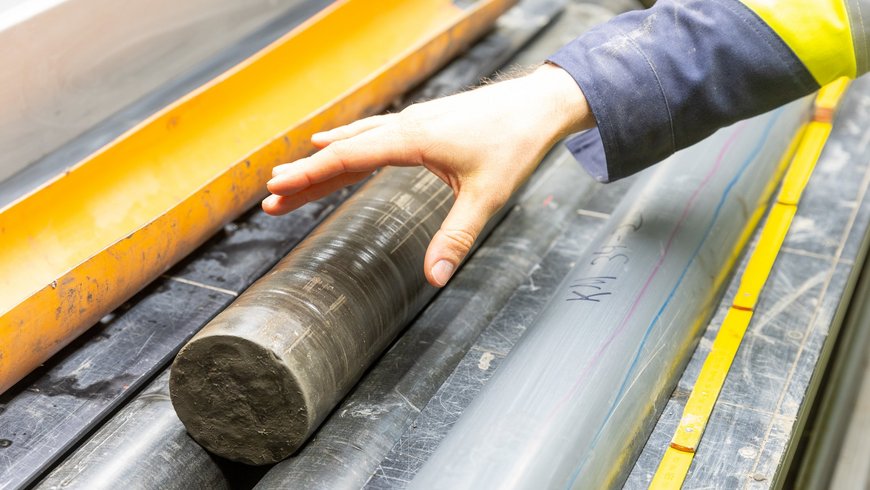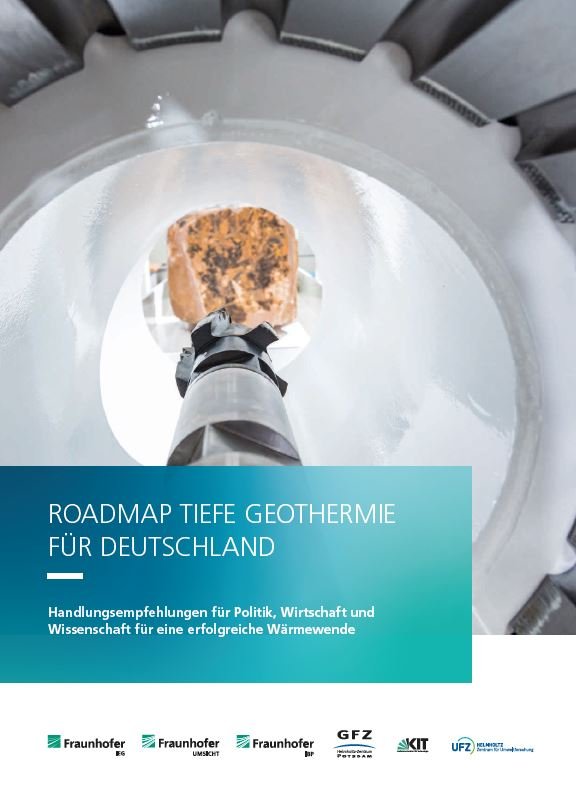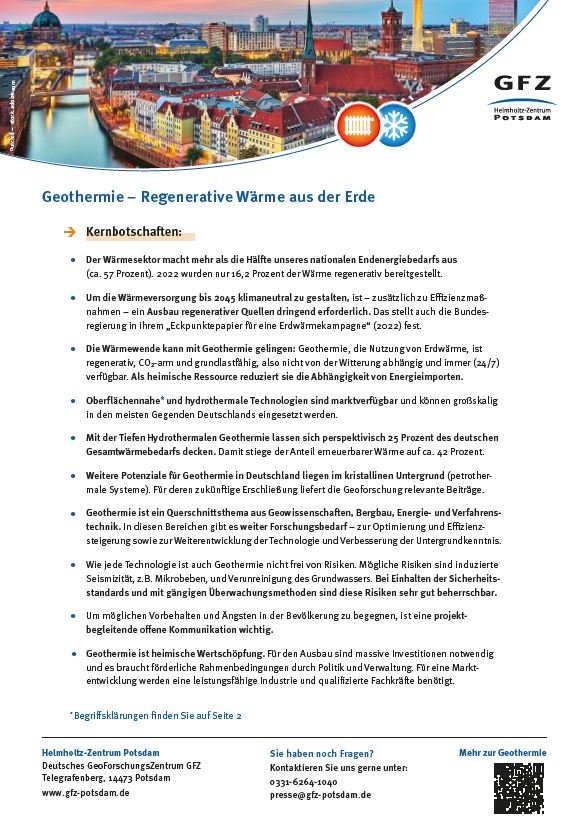Geothermal energy - regenerative heat from the earth
The heating sector accounts for more than half of Germany's final energy demand. The vast majority of the heat required - currently more than 80 per cent - comes from non-renewable energy sources such as coal, gas or mineral oils.
Geothermal and environmental heat make up just 1.9 per cent of the heat generation mix in Germany (Federal Environment Agency, Feb. 2023). Geothermal energy could play a much greater role, as the potential is immense: over 300 terawatt hours per year - around a quarter of the heat demand - can be covered by deep geothermal energy systems plus high-temperature storage and mine water utilisation.
Added to this are the near-surface geothermal systems for heating and cooling in new buildings, so that an expansion target of around 500 terawatt hours per year from geothermal energy seems realistic. If the potential of petrothermal systems is added in the long term, the contribution is significantly higher (Roadmap Deep Geothermal Energy for Germany).
The use of geothermal energy, which has been established for years, has many advantages because geothermal energy is
- renewable, i.e. regenerative
- low in CO₂
- base-load capable = permanently available, independent of the time of day, season or weather conditions
- local
- ready for use
- space-saving = suitable for cities
In Germany, the focus is on heat and cold supply. Increasingly, the seasonal storage of surplus heat underground is also being promoted as a further field of geothermal energy. At high underground temperatures, electricity can also be generated from geothermal energy.
The short-term potential lies in the expansion of hydrothermal geothermal energy, with far greater potential in the crystalline underground.
Geothermal energy can be extracted at various depths. The GFZ focuses on research on medium and deep geothermal systems (from a depth of 400 metres).
BMWK: Key issues paper for a geothermal energy campaign
Geothermal energy for the heating transition
In November 2022, the Federal Ministry for Economic Affairs and Climate Protection formulated targets for the heating transition in a key issues paper. This includes the strategic expansion plans for geothermal projects. There is a close technical exchange in which the GFZ is involved. In addition, the agreements in the coalition agreement show that the expansion is to proceed quickly. The declared goal is to generate half of our heat in a climate-neutral way by 2030; by 2045, the heat supply should be completely climate-neutral.
![[Translate to English:] Wie heiß ist es im Untergrund in Deutschland? [Translate to English:] 2 Karten von Deutschland, die Temperaturen im Untergrund in gelb, rot (sehr hohe Temperaturen) und blau zeigen](/fileadmin/_processed_/d/e/csm_Temperaturen_in_1_und_3km_Tiefe_86974ba40a.png)
Areas in Germany with great potential for geothermal energy
![[Translate to English:] in Norddeutschland tiefe Sedimentbecken mit Sedimentmächtigkeiten von bis zu 10km, metamorphe Gesteine (u.a. Region um Düsseldorf und Wiesbaden), magmatische und hochmetamorphe Gesteine (Grenze zu Tschechien und Grenze zu Frankreich (Nähe Freiburg)](/fileadmin/_processed_/2/9/csm_Basisinformationen_zum_tieferen_Untergrund_von_Norddeutschland_BGR2014_Q_4d28f59361.jpeg)
The most favourable areas for geothermal energy in Germany include
- Southern German Molasse Basin
The region in the foothills of the Alps that has absorbed the weathering debris of the rising mountains is known as the "Molasse Basin". The South German Molasse Basin stretches from Switzerland via Baden-Württemberg to Bavaria and Austria.
How warm? Temperatures between 100 and 155 °C with correspondingly high permeability are possible south of Munich and in the area of Lake Chiemsee (depth: approx. 4,000 m).
Suitable are: The Jurassic carbonates are particularly suitable, as they are partially dissolved and therefore permeable.
- Upper Rhine Graben
The Upper Rhine Graben stretches along the Rhine between the Swiss Jura in the south and the Taunus in the north.
How warm? At comparable depths, the Upper Rhine Graben has the highest underground temperatures measured in Germany to date, e.g. over 170 °C at a depth of 3000 m in the Karlsruhe/Mannheim area.
Suitable are: Sedimentary rocks and transitional horizons in the bedrock with 130 to 180 °C hot thermal water. In the Oberrheingraben, fissured areas of the bedrock also have excellent reservoir properties in some cases.
- North German Basin
The North German Basin extends from southern Lower Saxony to below the North and Baltic Seas. From a geothermal point of view, it is particularly advantageous that this structure contains at least six different layers with hydrothermal deposits, e.g. in Potsdam at a depth of 1200 metres, temperatures of 45 degrees are already reached with high productivity, and at great depths (4,000-5,000 m) temperatures of 130-160 degrees. Due to the strong movements of the salt formations in the North German Basin, which took place in geological time, the North German Basin is tectonically highly fissured and therefore highly permeable in many areas, making it very interesting for geothermal development.
How warm? Temperatures of 130 to 160 °C are found at 4,000 to 5,000 metres.
Suitable are: Conglomerates and sandstones down to a depth of 5,000 metres.
- Bedrock = 95% of the geothermal energy potential
Bedrock is the term for the geologically old, tectonically deformed (folded) crustal areas of a continent. It is the focus of petrothermal energy, which still requires basic research in some areas. The GFZ is involved in this, e.g. with the GeoLAB research infrastructure and the GeoReal project. In this way, the GFZ is contributing to the development of this enormous resource with a medium-term perspective.
How warm? Temperatures of 130°C to 220°C can be found at a depth of 5,000 metres.
Suitable are: Older crystalline rocks belonging to the bedrock, such as granite, gneiss or marble. In most parts of Germany, crystalline rock is found in deep underground German low mountain ranges, from the Sudeten Mountains to the Black Forest and the Eifel.
So suitable is Berlin?
Up to 85 degrees Celsius at at depth of two Kilometres
![[Translate to English:] stark schematisiertes 3D Untergrund-Modell Berlins](/fileadmin/_processed_/f/9/csm_Berlin_3D_v2_1__661212aff1.png)
In principle, the natural potential for geothermal energy in Berlin is huge, but so is the demand for heat in the capital city with almost 4 million inhabitants. The initial expansion target is to cover 15 - 20 % of Berlin's demand with geothermal energy. The North German Basin with Berlin and Brandenburg is a naturally favourable area and well suited for geothermal energy.
There are open and closed systems that are used near the surface, medium-deep and deep. The deeper the system, the higher the usable temperatures. Depending on the depth and dimensions of the projects, individual buildings, neighbourhoods or entire districts are supplied with heat. Both hydrothermal and near-surface technologies are available on the market across the board. Geothermal utilisation technologies include geothermal probes and collectors as well as hydrothermal and petrothermal systems.
The most important recommendations at a glance
Recommendations from science to politics
Developed jointly by the Fraunhofer Gesellschaft, the GFZ German Research Centre for Geosciences, the Karlsruhe Institute of Technology and the Helmholtz Centre for Environmental Research UFZ. Can be read in the "Roadmap Tiefe Geothermie für Deutschland".
The strategy paper makes five recommendations for the expansion of geothermal energy:
- Define expansion targets for deep geothermal energy
Politicians must formulate clear expansion targets and legislators must back these up with regulations. This includes accelerated approval procedures with a concentration effect as well as reviewing the adaptation of laws (e.g. BBergG, WHG, BauGB, UVPG, GEG) and the designation of preferred areas in the regional development plans of the federal states and in municipal land use plans. At the same time, policymakers must make CO₂ avoidance costs a key regulatory tool and the system of charges and levies for municipal and industrial producers and operators must be levelled and simplified.
- Minimising the risk of discovery
Effective instruments are needed in the short term to minimise the risk of discovery: in economic terms, these are financial tools and a noticeable increase in the annual funding volume of the "Federal Subsidy for Efficient Heating Networks (BEW)" to well over EUR 1 billion. Technically, this includes
geophysical investigations in metropolitan areas as part of the geological surveys and an exploration drilling programme to reduce the exploration risk, as well as demonstration and pilot plants with close scientific support.
- Invest in key technologies
Investments in 10-year key technologies for expansion to a large industrial scale by industry and accompanying government funding programmes; e.g. in drilling and reservoir technologies (incl. engineered geothermal systems), borehole pumps, high-temperature heat pumps, development of large heat storage systems, the expansion of trans-municipal heating networks and cross-sectoral system integration. Comprehensive digitalisation must become the basis for the analysis, planning, integration, control and monitoring of complex energy systems.
- Train skilled labour
Activation of the high value creation and labour market potential of 5 to 10 people per megawatt of installed capacity along the value chain of research and development, component production, administration, plant construction and operation through innovation and business promotion measures. Accompanying education policy measures (curricula, further training, inter-company training centres, recruitment programmes) are needed to eliminate the lack of personnel capacities.
- Interact with citizens
Broad public outreach must be initiated and proactively supported politically. The promotion of positive anticipation and acceptance in society requires a targeted strategy for interaction with citizens and stakeholders, especially at municipal level, which creates participatory opportunities.
What do we do at GFZ?

We conduct basic research in the fields of deep, superheated and supercritical geothermal energy and in the crystalline subsurface (GeoLaB, KTB). Scientists in the "Geoenergy" section are increasingly focussing on the interaction between reservoirs and fluids.
We bear innovation risks
Basic research can be economically too risky for individual companies. With our basic research, we bear some of the research and innovation risks associated with the development of any technology. Our research minimises the so-called discovery risk. We investigate where the subsurface is warm and permeable enough to utilise geothermal energy.
We operate demonstration and research platforms
To disseminate and scale up the extensive experiments in the laboratory and technical centre, the GFZ operates its own and cooperative, industry-compatible demonstration and research platforms in medium and deep geothermal energy.
We conduct research on
- hydrothermal geoenergy
- urban cooling and heating supply
- aquifer storage (ATES), convective
- conductive heat storage (BTES)
- petrothermal energy
- supercritical geothermal energy
- geothermal fluids
- Integrity of boreholes
- Drilling methods
- Measurement technology for drilling
The German Research Centre for Geosciences has the largest group of scientists and engineers in Europe conducting research in the "Geoenergy" section on the use of medium and deep geothermal energy and the storage of renewable heat. With broad expertise, all disciplines are covered - from the exploration of deposits and their development through drilling and engineering services to the conversion and distribution of energy.
- Answers to frequently asked questions (German only)
- Lexicon


![[Translate to English:] Großstadt beleuchtet - Abendlicht](/fileadmin/_processed_/f/4/csm_Geothermie-AdobeStock_55406660-web1_d76a88f59c.jpeg)
![[Translate to English:] Bereitstellung von Wärme, Kälte oder Strom mit geothermischen Systemen Different geothermal technologies](/fileadmin/_processed_/4/a/csm_Technologiefamilie_Geothermie_5dc5772d73.png)
![[Translate to English:] Wortwolke](/fileadmin/_processed_/0/b/csm_wordcloud_Schlagworte_Geothermie3_05b7a87bf5.jpeg)






